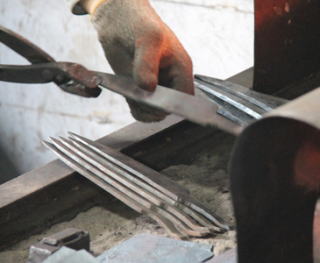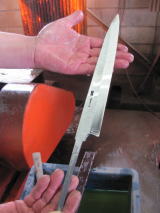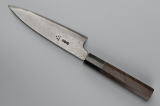Selection of steel and ground steel
- 製作する刃物に合わせて鋼・地鉄を選びます。
- 鋼(はがね)は、炭素量が高く硬い材料で包丁の切れる刃の部分になります。出来上がる包丁の用途によって様々な鋼を使い分けます。
- 地鉄(じてつ)は、炭素量が低く柔らかい材料で極軟鋼とも呼ばれています。硬く、脆い「鋼」と接合させて、強度を持たせるために使用されます。
- Select the steel or jitetsu based on the blade to be made.
- Steel is a hard material with a high carbon content and is used to make the blade of a kitchen knife. Various types of steel are used depending on the purpose of the finished knife.
- Jitetsu is a soft material with a low carbon content, also known as very soft steel. It is used to combine with hard, brittle steel to give it strength.
Steel and Geotechnical Iron Composition
| 成分 Constituents |
地鉄(%) Local iron |
スチール(%) Steel |
| C(炭素 (carbon) |
0.08 | 1.0〜1.2 |
| Si(ケイ素) Silicon |
- | <0.2 |
| Mn(マンガン) (manganese) |
0.35 | <0.35 |
| P(リン) (phosphorus) |
0.009 | <0.03 |
| S(イオウ) (sulfur) |
0.02 | <0.02 |
| Cr(クロームm) (chrome m) |
- | 0.5 |
| W(タングステン) (tungsten) |
- | 1.0〜1.5 |
| V(バナジウム) (Vanadium) |
- | - |
(たんせつ)
Forge welding
- 鋼と地鉄を接合する。
- 形を整えた地鉄と鋼を重ね合わせ、かまど型の炉の中で約1200℃まで熱し、一気に打ち合わせて刃物の原型を打ち出します。
この時、地鉄と鋼の間に鍛接剤(たんせつざい)を撒きます。高温で溶けた鍛接剤が接着剤の役割を果たし、打ち合わせた際に火花となって飛び出し、鋼と地鉄の不純物や酸化鉄の被膜を取り除き、より良質な状態にする役目も持っています。 - Steel and Jitetsu are joined together.
- The shaped Jitetsu and the steel are superimposed and heated in a furnace to about 1,200 degrees Celsius in a kamado-type furnace, and then hammered together in one go to create a blade prototype.
At this point, a welding agent is applied between the Jitetsu and the steel. The welding agent melted at high temperature plays the role of an adhesive and sparks are emitted as sparks when the steel and tJitetsu are hammered together. It also serves to remove iron impurities and iron oxide coatings, making it a better quality product.




Rough spread
Forging
- 刃物の型に合わせて大きく延ばす。
鍛接した刃物の原型を再び炉の中で熱して寸法に合わせて大きく打ち伸ばし、大まかな形と厚さを整えます。金属内部の粒子が細かく複雑になり刃物の切れ味の持続性、刃物の耐久性が増していきます。 - The blade molds are greatly stretched to fit the mold of the blade.
Forged blades are reheated in the furnace and stretched to fit the size of the original shape of the blade to adjust the rough shape and thickness.
The particles inside the metal become finer and more complex, which increases the durability of the blade and the durability of the blade.


(やきならし)
Baking
- 鋼の結晶粒を細かにし、炭化物の球状化・・・球状化セメンタイト→高炭素の鋼の熱処理後の機械的性質を向上させる。
- 炉の温度に気を配りながら表面の酸化鉄の被膜を落とし、刃物の表面を滑らかに仕上げていきます。この工程で更に金属の粒子が細かく複雑になり、より刃物の切れ味の持続性、耐久性が増していきます。
- Fine grained steel grains and spherical carbides ... spherical cementite -> improve the mechanical properties of high carbon steel after heat treatment.
- While paying attention to the temperature of the furnace, the iron oxide film on the surface is removed and the surface of the blade is finished smooth.
In this process, the metal particles become finer and more complex, and the sharpness and durability of the blade are further increased.

(やきなまし)
Annealing
- 加工による内部歪性の除去及び炭化物球状化を行う。
鋼の組織を均一化するため、低温で刃物を熱して、あく藁(藁灰)の中で時間をかけて冷却してゆきます。こうすることで金属の中に溜まった内部応力(圧力や収縮しようとする力)や歪みが取り除かれてより強靭な刃物になります。 - Removal of internal distortions and spherification of carbides by machining.
- In order to homogenize the steel structure, the blade is heated at low temperature and cooled in drilling straw (straw ashes) for a long time. This is the process of removing internal stresses (pressure and contraction forces) and distortions from the metal. In this way, the internal stresses (pressure and the force of contraction) and distortions built up in the metal are removed and the metal is then subjected to the same process. It is a tougher blade than the other two.
Molding process
- 形状を整える。
必要な寸法より大きく伸ばした刃物をグラインダーなどの切削工具を使い、刃物の形へと削りだしてゆきます。 - Shape the blade.
The blade is stretched to a larger size than required and then cut into the shape of the blade using a grinder or other cutting tool.



仕作り
Empty strikes
- 焼き入れ時の形状を考えての冷間加工。
冷間鍛造ともいい、常温や僅かに熱した状態で打ち鍛えることで更に金属の粒子を細かくし、刃物に強靭さを持たせます。 - Considering the shape of the blade at the time of quenching, cold forging is also called cold forging.
This is also called cold forging, where metal particles are made finer by hammering and forging at room temperature or slightly heated to make the blade tougher.

(くろかわじょきょ)
Removal of black skin
- 焼きムラ等、防止の為、研削砥石を使用して黒皮を落とす。
- 鍛造した刃物の表面には酸化被膜(黒皮)が付いており、そのままでは焼き入れの際に鋼まで熱が伝わりません。表面を研磨して黒皮を除去することで焼き入れ性を向上させます。
- To prevent uneven hardening, use a grinding wheel to remove the black skin.
- The surface of the forged blade has a black oxide layer (black skin) on it, and if this layer is not removed, the steel is heated during quenching. is not transmitted. The hardening process is improved by polishing the surface to remove the black skin.

(やきいれ)
Hardening
- 水焼き、油焼きで焼き入れの熱処理を行い、「硬化させる。
- 熱した刃物を水や油の中に入れて急冷することで鋼が硬化し、よく切れ、切れ味が持続する刃物になります。しかし、焼き入れの際に高温になりすぎると鋼が脆く、切れ味が悪くなってしまうため徹底した温度管理のもとで行われます。
- The steel is "hardened" by quenching heat treatment in water or oil quenching.
- The steel is hardened by placing the heated blade in water or oil and cooling it rapidly to produce a blade that cuts well and keeps its sharpness.
However, if the temperature is too high during quenching, the steel becomes brittle and the sharpness of the blade is reduced, so this process is carried out under thorough temperature control.

(やきもどし)
Tempering
- 硬さの調節。焼き戻し油の中に刃物を入れて靱性を持たせる。
- 焼き入れをした刃物はそのままでは脆く弱い熱を加えて適度な柔らかさを持たせます。
そうすることで欠けにくくより実用的な状態になります。 - Hardness adjustment. The blade is placed in the tempering oil to make it
tougher.
- Hardened blades are brittle in their original state and are made soft by applying heat to them.
This will make it less prone to chipping and more practical.
Distortion and Kruitt removal
- 熱処理(焼き入れ)で出た歪を取る。
- 焼き入れの際、鋼の収縮で生じる歪み、クルイを銅製の小槌などで叩きながら丁寧に修正してゆきます。こうすることでまっすぐで、より扱いやすい包丁となります。
- The distortions produced by heat treatment (quenching) are removed.
- During quenching, the strains and kruis produced by the contraction of the steel are carefully corrected by tapping them with a copper mallet. Yield. This will make the knife straighter and more manageable.

Blade setting
- 研削。
水掛け砥石を用いて刃物に刃を付ける。
回転砥石と呼ばれる機械で研いでいく際に摩擦熱が加わり、焼き入れした鋼が柔らかくなってしまうのを防ぐため水をかけながら丁寧に刃を研ぎ出してゆきます。この際に焼き入れで出来た黒皮も落としてゆきます。 - Grinding.
A water-coated grinding wheel is used to apply the blade to the blade.
As the blade is sharpened with a machine called a rotary wheel, frictional heat is applied, which softens the hardened steel and The blade is carefully sharpened with water to prevent it from being damaged. At this time, the black bark created by quenching is also removed.




Polishing
- 水掛け砥石に黒皮等を落とし、エンドレスペーパー等で表面を磨く。
- 刃物の表面に切削痕が残っていると目に見えないゴミが溜まったり、水分が残り錆びやすく不衛生になってしまうため、エンドレスペーパー(回転式の紙ヤスリ)を使用し鏡面に近い状態まで研磨してゆきます。そうすることでより錆びにくく、衛生的な刃物になります。
- Clean the blade surface with a water-coated grinding stone and polish the surface with endless paper.
- If there are traces of cutting marks on the surface of the blade, invisible debris can accumulate and water can remain on the blade, making it prone to rusting. Use endless paper (a rotary paper file) to make it close to a mirrored surface because it becomes unsanitary. Polishing until the blade is polished. This will make the blade more rust resistant and hygienic.



Adding a handle
- 刃付けが完了した刃物等に柄を付ける。
少しずつ微調整を繰り返しながら柄に対して刃物がまっすぐになるように柄を取り付けてゆきます。
この際に刃物と柄の隙間から水が入り込み、刃物の差し込み部分が錆びるのを防ぐため、隙間にエポキシ樹脂を流し込み、更に固定します。 - Attach the handle to the blade that has been sharpened.
The handle is then attached to the handle by repeated fine adjustments to ensure that the blade is straight against the handle.
At this point, epoxy resin is poured into the gap between the blade and the handle to prevent water from entering the gap and rusting the blade insert.

Shipping
- こうしてこだわりぬいて手打ちで作ることで『折れず、曲がらず、よく切れる』刃物となり、お客様にご愛用していただくに相応しい仕上がりとなります。
- The blade is made by hand with such attention to detail that it is not broken, not bent, and sharp.
